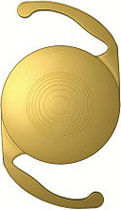
The ReSTOR multifocal is an intraocular lens that is implanted during cataract surgery after the cataract has been removed. In contrast to a standard monofocal lens, the ReSTOR multifocal allows patients to see both far and near in focus at the same time.
This lens comes in three different options which vary in how close the near vision is away from the patient’s face. Patients can chose a lens where the near vision is at an intermediate range (useful for seeing the computer screen), one where the near vision is a little closer (useful for reading the newspaper on a table), or one that is up close (useful for near-work activities).
The lens achieves this multifocal effect by having alternating rings of near and far vision, concentrated in the center of the lens. Peripherally, the lens is set to be focused to see at far distances. This means that the ability to see far and near is dependent on the pupil size (as opposed to the Tecnis Multifocal intraocular lens). As the pupil becomes smaller, the vision is split evenly with far and near. However, as the pupil increases in size, a larger percentage of vision is devoted to far vision.
This is important because with multifocals, there is an increased risk of seeing glare and halos around lights at night, caused by the rings meant for near vision. With the ReSTOR lens, these symptoms are minimized while at night because of the larger pupil. The near vision becomes stronger as the light is turned up (and the pupil size decreases). The compromise with this lens is that near vision is not as good in dimly lit environments, such as in restaurants.
When you come in for a cataract consultation, we can discuss whether this lens or another lens is best-suited for your particular day-to-day needs or lifestyle.